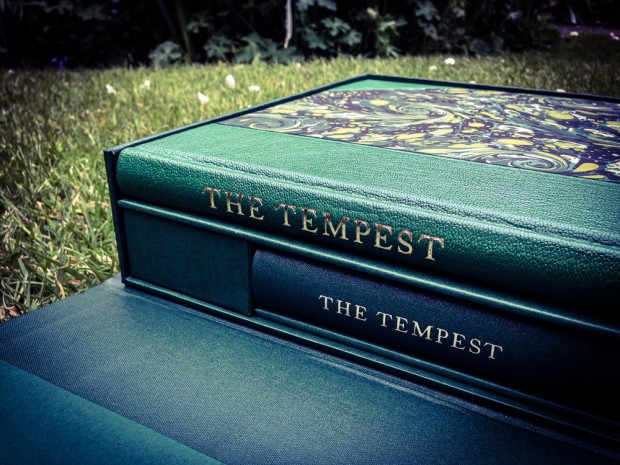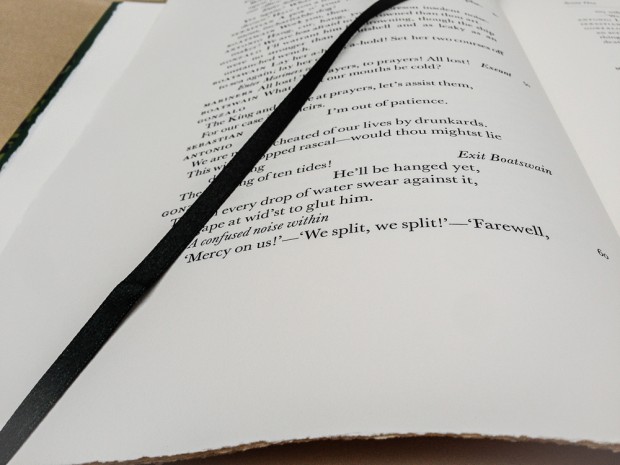You have no items in your cart. Want to get some nice things?
Go shopping The Folio Society has sent me a book to have a look at: its letterpress edition of Shakespeare’s The Tempest. I have to give it back when I’m done writing this. I’m tempted to write very slowly; it’s a beautiful book of hand-bound pages and gold leaf, and costs more than I could pay without wincing (£295). I find myself wondering whose shelf it will eventually grace; whether it will be alone amongst Ludlums or shoulder to shoulder with its brethren (the entire collection would set you back more than £11,000). I am very curious about who will own these books. Part of the pleasure of a second-hand book, of course, is to reflect on who might have held it previously, where, and in what frame of mind. It is less often that I question whom a book will go on to. I have left bags of books with charity shops, but seldom dwelt on what would become of them. This was probably a stoic reaction to the trauma of parting with so many bound pages. And then I left a copy of Hokkaido Highway Blues by Will Ferguson on a train once. I got off at Ely, or Peterborough, and the book went on to Cambridge. I hadn’t finished it but was almost out of patience with it anyway. I do remember wondering whether it would get on better with its finder.
The Folio Society has sent me a book to have a look at: its letterpress edition of Shakespeare’s The Tempest. I have to give it back when I’m done writing this. I’m tempted to write very slowly; it’s a beautiful book of hand-bound pages and gold leaf, and costs more than I could pay without wincing (£295). I find myself wondering whose shelf it will eventually grace; whether it will be alone amongst Ludlums or shoulder to shoulder with its brethren (the entire collection would set you back more than £11,000). I am very curious about who will own these books. Part of the pleasure of a second-hand book, of course, is to reflect on who might have held it previously, where, and in what frame of mind. It is less often that I question whom a book will go on to. I have left bags of books with charity shops, but seldom dwelt on what would become of them. This was probably a stoic reaction to the trauma of parting with so many bound pages. And then I left a copy of Hokkaido Highway Blues by Will Ferguson on a train once. I got off at Ely, or Peterborough, and the book went on to Cambridge. I hadn’t finished it but was almost out of patience with it anyway. I do remember wondering whether it would get on better with its finder.
My review copy of The Tempest is in fact a lettered edition (R) and not for sale, but let’s not allow that to stop us from imagining where it might one day end up. The Folio Society won’t be around for ever, hoarding its lettered editions on Eagle Street, and certainly society will one day crumble: perhaps HG Wells’ time traveller will find this edition of The Tempest mouldering amongst the unread books of the Eloi. Then there are the numbered editions, which will find their way into the hands of eager buyers — will they be bought as a treasured item or as a by-the-metre order placed by a personal shopper? Will the sheer size of these editions take them aback? In its solander box my copy is more or less thirty centimetres by forty. How many of these books will be lifted from their case? How many owners will bend to sniff the ripe aroma of the leather? The Folio Society tells me that the goatskin for the binding came from the Sahel region of Nigeria, which is an extraordinary detail, really, like knowing the name of the cow your brisket came from. I sniff the book again, stupidly seeking a suggestion of the savanna, although I know the leather was actually tanned in Northamptonshire. The case sides of the volume were marbled by an artist in Kent. The paper, showing the deckle edge of its manufacture, was made in Hürtgenwald, and the type was set by a firm in Germany. The Folio Society has neglected to mention whence the place-holding ribbon came, but some things must be left to the imagination.
 The mysterious future owner of this book is not the only faceless figure crowding around the volume as I read; the goatherd, the tanner and the binder are present too. The marbler and the printers of certain editions (not mine) need not remain faceless — two of them have been interviewed for the Folio Society’s website. Jemma Lewis talks winningly about the marbling process, which is carried out on the surface of a solution of carrageen moss (which sounds more like the base for a Yotam Ottolenghi soup to me but what do I know). The paper itself is treated with alum before being applied to the pre-swirled paint. With details like this a book can communicate through much more than words alone. Take alum, which I find a particularly redolent word, summoning images of the mine-pocked North Yorkshire coast, rocky shores criss-crossed by the trackways of narrow-gauge cart rails from which waiting barquentines could be loaded with their chemical cargo.
The mysterious future owner of this book is not the only faceless figure crowding around the volume as I read; the goatherd, the tanner and the binder are present too. The marbler and the printers of certain editions (not mine) need not remain faceless — two of them have been interviewed for the Folio Society’s website. Jemma Lewis talks winningly about the marbling process, which is carried out on the surface of a solution of carrageen moss (which sounds more like the base for a Yotam Ottolenghi soup to me but what do I know). The paper itself is treated with alum before being applied to the pre-swirled paint. With details like this a book can communicate through much more than words alone. Take alum, which I find a particularly redolent word, summoning images of the mine-pocked North Yorkshire coast, rocky shores criss-crossed by the trackways of narrow-gauge cart rails from which waiting barquentines could be loaded with their chemical cargo.
Of course a book generally needs to communicate something with its words as well, and those in The Tempest are famously pretty good. Here, I am told, these words are set in ‘monotype’ Baskerville and Caslon. I know Baskerville from the dropdown menu in Word but have never thought to use it. It looks good here, and I bought a font for the first time earlier this year (Halis Rounded, as you ask) so feel qualified to say so. The book’s large format shows off the type beautifully, with wide margins that beg to be scribbled in (although of course you wouldn’t dare). Of all the work that has gone into making these books, the type is probably the most captivating. The thought that every single letter came from an individual metal body that was set into place by hand is almost too much to take in, and yet this process has been carried out millions of times over hundreds of years. The type is melted down, which strikes me as an act of almost medieval violence. As far as I know, only the type suffered; all those involved in the production of these books were allowed to keep their heads. Except for the goats. They were skinned, dismembered, made use of.
 I am happy for the Folio Society. In a period when the very form of the book is being questioned, they are more relevant than ever. This letterpress edition of Shakespeare is beautiful in a way books seldom are, and almost compels me to throw my e-reader from the window of a train. But if I were to do that I would have to throw away my Penguin paperbacks too, for every method of printing that followed the letterpress could be seen as a diminishing of the form. The painstaking process of achieving such exquisite regularity by hand must be exhausting (each book in this series took about six weeks to print) and it is impossible not to value the result. The letterpress Shakespeare is an expensive line of books — one percent expensive, really — but I can’t object. Somehow we must keep finding the means to let skilled people make beautiful things. These objects must exist so the rest of us can dream about them.
I am happy for the Folio Society. In a period when the very form of the book is being questioned, they are more relevant than ever. This letterpress edition of Shakespeare is beautiful in a way books seldom are, and almost compels me to throw my e-reader from the window of a train. But if I were to do that I would have to throw away my Penguin paperbacks too, for every method of printing that followed the letterpress could be seen as a diminishing of the form. The painstaking process of achieving such exquisite regularity by hand must be exhausting (each book in this series took about six weeks to print) and it is impossible not to value the result. The letterpress Shakespeare is an expensive line of books — one percent expensive, really — but I can’t object. Somehow we must keep finding the means to let skilled people make beautiful things. These objects must exist so the rest of us can dream about them.


About James Field
James Field is the Book Reviews & Online Essays Editor at Litro and is also the editor of a children's literary journal, Lamplands. He currently finds himself in London where he is reconciliatory. His typing speed is 65 wpm, he has 25 Steam achievement points, and he has recently become comfortable with swearing around his family.




